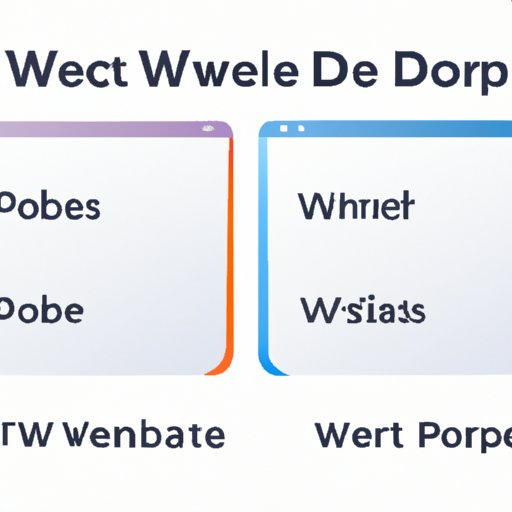Introduction
Web development is a broad field that encompasses a range of disciplines related to creating websites and applications for the internet. It involves the use of technologies such as HTML, CSS, JavaScript, and more advanced tools such as frameworks and databases. Computer science, on the other hand, is the study of algorithms, data structures, and other computing concepts. While there are clear differences between the two fields, they are also closely intertwined.

Exploring the Role of Web Development in Computer Science
Web development and computer science have many similarities. Both involve the use of programming languages and data structures, and both require a deep understanding of algorithms and software engineering principles. Additionally, web development relies heavily on computer science concepts such as network security, encryption techniques, and database design.
At the same time, web development is an extension of computer science. It builds upon core computer science concepts and applies them to the development of websites and applications. Web developers need to understand the fundamentals of computer science in order to create robust and secure web applications.

A Comparison of Different Web Development Frameworks
Web development frameworks provide a set of tools and libraries that make it easier to develop websites and applications. Popular frameworks include React, Angular, and Vue.js. Each framework has its own unique features and advantages, so it’s important to consider which framework is best suited for a particular project.
When comparing different web development frameworks, it’s important to examine their features, such as the type of code structure they use, the number of supported platforms, and the level of customization available. It’s also important to consider the pros and cons of each framework, such as ease of use, scalability, and security.
An Introduction to HTML and CSS for Computer Scientists
HTML and CSS are the building blocks of all websites and web applications, and they are essential for any web developer. HTML is used to define the content and structure of a webpage, while CSS is used to style and layout the page. Computer scientists need to understand the basics of HTML and CSS in order to create webpages and applications.
To get started with HTML and CSS, computer scientists should learn the fundamentals of both languages, including the syntax and structure of each language. Once they have a basic understanding of HTML and CSS, they can begin to build a basic webpage using HTML tags and CSS styles. They can then explore more advanced features such as animations, transitions, and responsive design.

Developing Secure Websites with Computer Science Principles
Security is a critical consideration for any web application, and computer science principles can be used to strengthen the security of a website or application. Security principles such as authentication, authorization, and encryption can be applied to web development to protect user data and prevent malicious attacks.
Web developers should also analyze the potential weaknesses of a website or application, such as cross-site scripting (XSS) vulnerabilities and SQL injection attacks. They should then incorporate encryption techniques such as hashing, digital signatures, and public key infrastructure (PKI) into their web applications to ensure a secure environment.
Using Artificial Intelligence in Web Development
Artificial intelligence (AI) is becoming increasingly prevalent in web development. AI-based solutions can be used to automate processes such as testing and debugging, as well as to improve the user experience of a website or application. AI can also be used to enhance security by detecting and responding to malicious activity in real time.
Computer scientists should understand the basics of AI in order to effectively utilize AI-based solutions in web development. They should also be familiar with existing AI tools and frameworks, such as TensorFlow and PyTorch, and understand the various types of machine learning algorithms.
Understanding Database Design for Web Applications
Database design is an essential component of web development, as it provides a way to store and retrieve data from a website or application. Different types of databases can be used depending on the requirements of the project, such as relational databases, NoSQL databases, and in-memory databases. Computer scientists should understand the basics of database design in order to create effective database structures for web applications.
Computer scientists should also understand the principles of normalization and denormalization, and how they can be used to optimize database performance. Additionally, they should be familiar with SQL and NoSQL query languages in order to query databases and manipulate data.
Conclusion
Web development and computer science are closely intertwined, and understanding the relationship between the two fields is essential for any web developer. This article explored the role of web development in computer science, compared different web development frameworks, provided an introduction to HTML and CSS for computer scientists, examined how principles of computer science can be used to develop secure websites, and discussed the use of artificial intelligence and database design in web development.
(Note: Is this article not meeting your expectations? Do you have knowledge or insights to share? Unlock new opportunities and expand your reach by joining our authors team. Click Registration to join us and share your expertise with our readers.)
